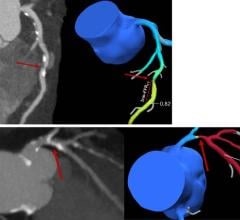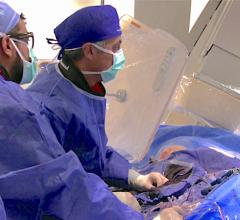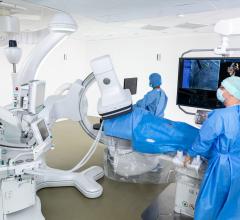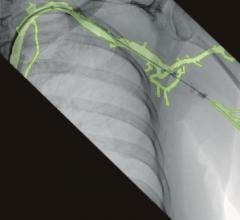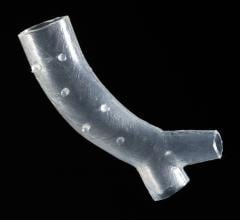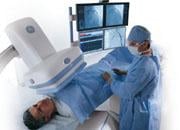
July 27, 2011 – As the number of interventional procedures to diagnose and treat patients increases worldwide, and the procedures grow in complexity and length, exposure to radiation is a growing concern for both clinicians and patients. Interventional fluoroscopy is the third largest source of radiation from medical procedures, accounting for about 7 percent of the total radiation exposure of Americans in a year, according to a study by the National Council on Radiation Protection. GE Healthcare’s Innova imaging systems help clinicians reduce radiation exposure without compromising the image quality they need to make confident decisions during interventional procedures.
Independent studies confirm that, when operating under live fluoroscopy, GE’s Innova doses are 22-75 percent lower than other flat panel detector systems. The company said is offers three following technology pillars to help minimization dose:
Dose Efficient Technology
GE’s Innova flat-panel detector provides very good detective quantum efficiency (DQE), a parameter internationally accepted as the best index of detector performance in the contrast- and dose-limited imaging done in actual clinical studies. High DQE enables better quality images at the same dose, or the same quality image at a lower dose. This attribute provides a 12-50 percent advantage in fluoroscopy.
The high power and high heat-dissipation capability of the Innova X-ray tube enables spectral filtration for X-ray beam hardening to deliver a more monochromatic and efficient beam. Harder X-ray beams avoid unnecessary absorption by the body, minimizing the unnecessary radiation.
Copper spectral beam filters located in the collimator are available in several thicknesses and are under automatic system control, for more versatile, uniform beam-hardening performance. Combined with the tube technology, more efficient radiation dose management can be achieved.
Dose Reduction Techniques
A variety of Innova dose-reduction features, all controlled from the tableside, help clinicians further reduce radiation dose exposure during procedures.
Dynamic range management helps reduce problems with image blackout and burnout by extracting relevant image information, transforming background thicknesses and then restoring structures of interest. Dose saving features include FluoroStore, which lets clinicians store fluoro sequences in lieu of high-dose image acquisition modes, and virtual collimation, which lets clinicians preview collimator positioning without additional radiation exposure. InnovaSense patient contouring technology also automatically minimizes detector-to-patient distance to help reduce patient skin dose.
Dose Management Tools
Innova’s smart system design integrates tableside dose management tools right into the procedural workflow. Offering automation and flexibility, these tools help clinicians adapt to a wide range of imaging situations.
The automatic exposure (AutoEx) control system automatically and continuously adapts to help keep image quality and patient dose at optimum levels, reducing patient dose by as much as 40 percent without compromising image quality. With Innova Dose Personalization, clinicians can also choose from five different AutoEx default preferences, or program from any of these in any protocol to enable multi-procedure, multi-user customization. In addition, direct dose management at the tableside allows clinicians to instantly reduce dose by 50 percent. Together, these two features provide a 24:1 range in fluoro and 6:1 record dose rate adjustment. Linear dose reduction and balanced IQ and dose reduction strategies allow for step-by-step dose reductions, 50 percent and 25 percent respectively, to provide a 24:1 range in fluoro dose rate adjustment when combined with AutoEx preferences.
Innova dose monitoring and reporting capabilities help clinicians closely track and manage dose exposure. Clinicians can also view skin-dose profiles and dose-by-procedure-type reports, identify high-dose cases and help ensure that staff and patient dose levels stay within occupational standards. Innova Dose Reports provide an automated way to track system and dose utilization details at the point of care. Critical information, collected remotely via the InSite broadband connection to GE, is combined in comprehensive reports to illustrate procedure utilization, dose usage details per procedure, monthly dose utilization trends and benchmarking. Clinicians can receive near real-time alerts via email that extensively detail high dose exams, including the unique cumulative dose incidence map, which uses gantry angulations to estimate potential hot spots.
“Two major factors make attention to the patient’s radiation dose more important than ever: the increasing complexity of interventional procedures increase total X-ray dose, and the lack of ready access to radiation data by clinicians and medical physicists impedes radiation management,” says Stephen Balter, M.D., Ph.D., medical physicist at Columbia University Medical Center and chairman of NCRP’s Report 168: Radiation Dose Management for Fluoroscopically Guided Interventional Procedures. “Innova Dose Reports provide information on dose usage and specific procedural details. This improves clinical awareness of total radiation exposure.”
For more information: www.gehealthcare.com


 May 17, 2024
May 17, 2024 
